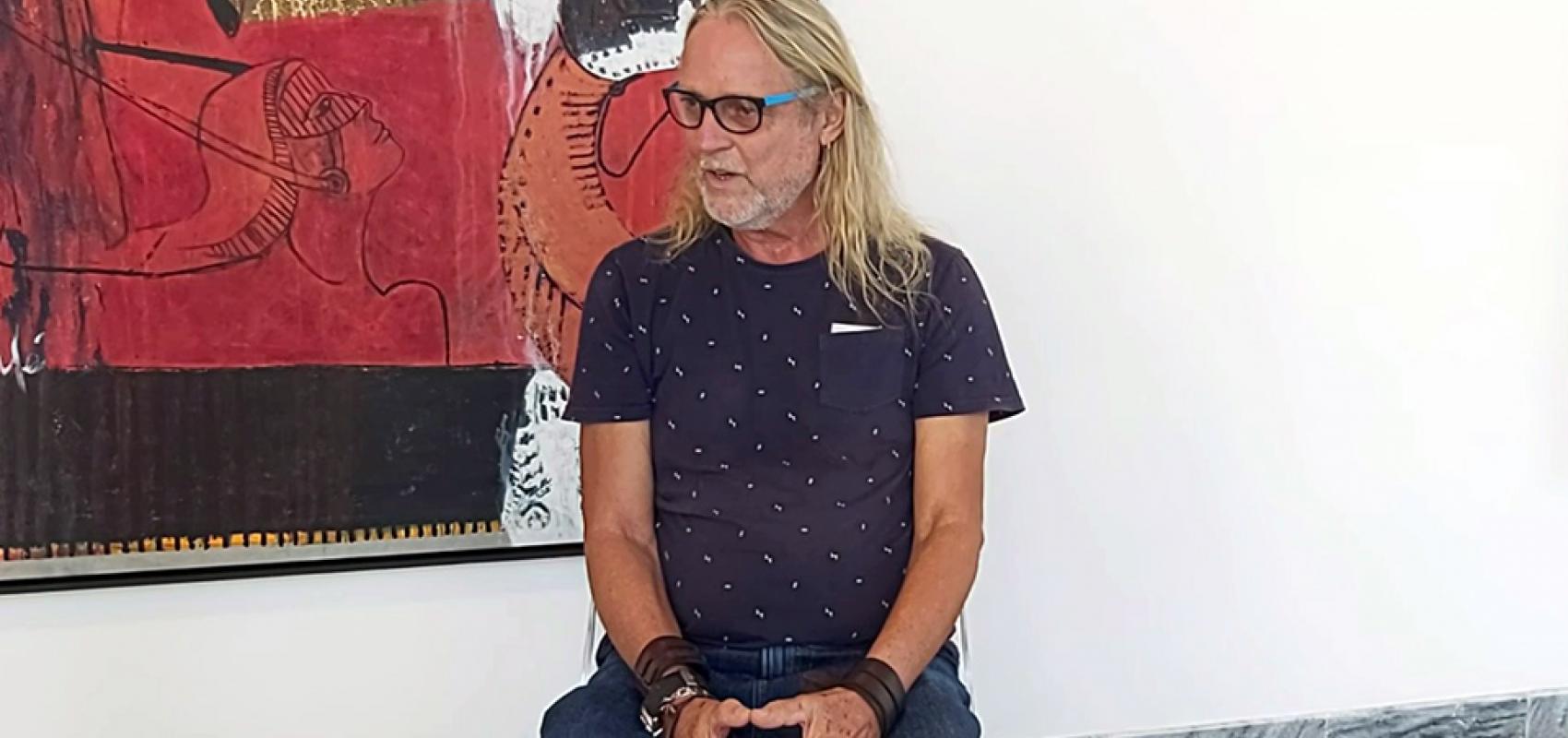Moises Finale is an unstoppable force. For the artist born in Cardenas, Matanzas, the period of creation can be any, the precise moment to go ahead with painting, ceramics or the format he chooses, always appears with that air of welcome of the good and incomparable moments.
Finalé is a consecrated creator in Cuba. A man who has experienced multiple cultures, thanks to his constant travels around the world. When his eyes catch a glimpse of other realities, his expressive capacity is strengthened because the mixtures, the plural and heterogeneous bring a richness that the Cuban painter knows how to take advantage of, and more than takes advantage of.
Influenced by African art, the work of Wifredo Lam, the beauty of women and other figurations, the author of emblematic pieces such as El Bosque de La Habana or Amores de los 80, Dulzuras Insulares or La Mañana, assures his happiness when the muses arrive: "I don't suffer when painting, I'm not one of those artists who get hysterical. Before starting a work, I go through a process of searching and reading, and when I start, I almost always know where I'm going".
A few minutes of interview with the Maxima gallery team were enough to know his interest and the advantages that the large format offers him in his creative style. This is what he confirms: "I feel very comfortable in the large format, it allows me to work techniques in a free way and that characterizes me. I use stitching, soft sculptures, wood, engraving and metal. I can do the same in a small work, but it doesn't allow those freedoms, as I said. It is sincerely a pleasure that I cannot avoid. They are difficult works to move, to exhibit and sell, but I will continue, as long as I have the strength, to make large-format works."
On September 27, 2019, on his birthday, Moises Finale inaugurated his personal exhibition in our gallery entitled Finale Worlds, an artistic project with excellent reception by the public by showing emblematic works of his authorship created long ago and rarely seen.
"This exhibition surprised me," Finalé acknowledges, "there are two ways of working, one is in which I conceive the exhibition, I organize it and I have an artistic proposal, where I look for the title, I think about it, I study a lot and above all to launch something new. I don't like to repeat the same thing. But I didn't organize this exhibition, I was in France and when I arrived in Havana I was surprised because there are works of many years, even 20 years old".
"They are pieces that I practically had for my collection, they respond to a stage where I was in France. They were seen in Europe or in the United States, but the Cuban public, in one way or another, did not see that work, so that's where we started," he explains.
As a man of sensibilities in art, he has been able to take advantage of his stays in Argentina, Peru, Mexico and Europe, to continue in the search for a new renovating and demanding painting for his intellect.
"I am, as an important Cuban critic used to say, like a photographic camera that archives everything it sees. My painting has been nourished by those trips and by my readings, which are disorganized, but I read. I have tried for many years not to betray my artistic proposal", he clarifies.
And how much has Paris enriched your work?
I left Cuba for France around 1984. I left at the age of 27 and I found myself in the City of Light, where the level of knowledge is great in museums, in art magazines, I saw for the first time live the works of the great artists we had studied through books or photographs. It was impressive.
There are changes, one settles down, one begins to meditate, there is not so much hurry in painting, there is pleasure in working, the materials become easier and life changes in many aspects. I discover African art, something I was interested in since Cuba, I see the great collections of African masks in Paris, here in Cuba they do not exist, we do not have that tradition, despite the fact that our culture is so strong in that sense.
In France I also discovered Lam's work for the first time, although there are pieces of his in the National Museum of Fine Arts, there I saw his pieces very closely and his whole biography that had come out. I was lucky that Pierre Gaudibert, who wrote the prologue of one of the first books about Lam and a great specialist of African art, also wrote about me.
What specific references do you have to Lam?
I started with a somewhat naïve aspect, which was to try to discover Lam's technique, how he managed to create those first, second and third planes, as we painters speak, that is, those depths. Little by little I became interested in his figuration and in the end I came to his spirituality, the way in which he appropriates African art to make his own visuality. In spite of maintaining a language that is often not known to the European public, his work manages to belong to everyone. Europeans assimilate it in an incredible way.
What do second and third dimensions allow him to do?
When I was young I painted two-dimensional works when everybody was doing conceptual art or using the minimum space to express themselves, we are talking about the 1980s, when conceptualism arrived in Cuba 10 or 15 years late. But it arrived and we assimilated it well.
We made a group, Cuatro por Cuatro, there was already Volumen I and another group called Hexágono. So our proposal was to continue within the two-dimensional painting with new ideas, touching on themes that had not been addressed so far, trying to change figuration and make it as contemporary as possible.
At that time I made some performances in Havana, I was always interested in the interactive, the idea of participation, so I invited several painters to work with me. With time in France, around the 90s, I started with metal sculpture, which I do not present alone in space, I always go to the two-dimensional plane and integrate it into the work.
Moises Finale has been able to give color, texture, intention and motifs to Cuban art, a path along which we all travel as a country, in one way or another, some more distant or skeptical, but in the end Cuba represents a creative destiny in any of its dimensions.





